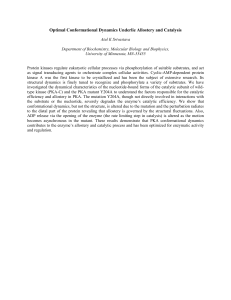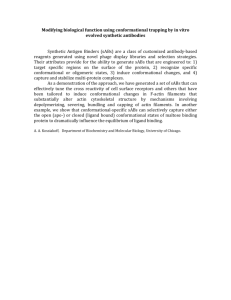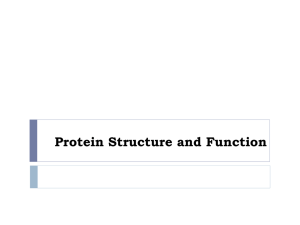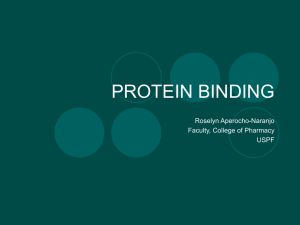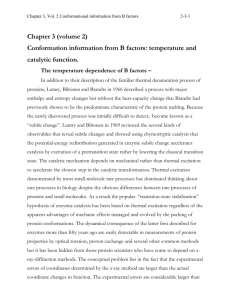Interactions and Equilibrium in Biomolecules
advertisement
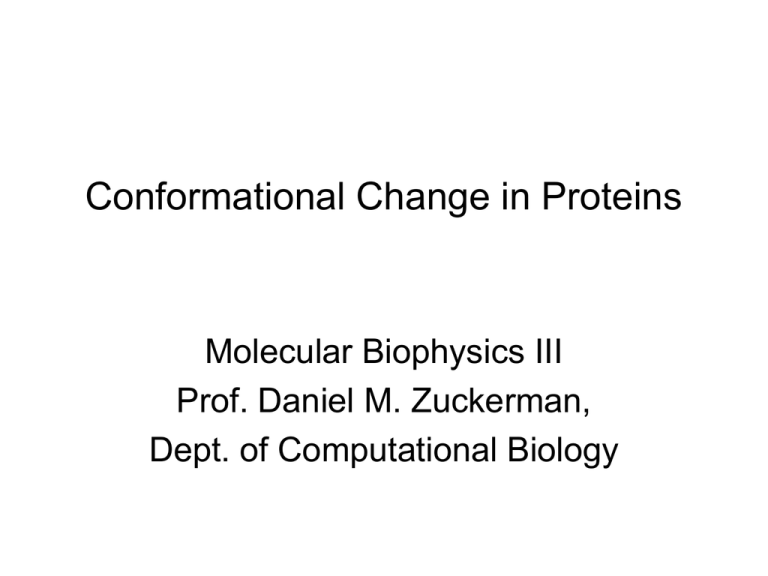
Conformational Change in Proteins Molecular Biophysics III Prof. Daniel M. Zuckerman, Dept. of Computational Biology Conformational Change & Function • Many (most?) proteins function via conformational changes • Outline – Ensemble Picture and Examples – Hemogolobin and allostery – Myosin, kinesin and motion – Functional motif for NTP hydrolysis – Calmodulin and signalling • Reference/reading: Berg et al., Biochemistry – Also source for figures Ensemble Picture (Statistical Mechanics) • An ensemble of paths, traversing ensembles of intermediate structures, connects two ensembles of structures intermediates structural ensemble A structural ensemble B Motor proteins Myosin Fluctuations in Biology • Regulation: fatty acid binding proteins Enzyme Conformational Change • Adenylate kinase Open/ligand-free Closed: Ligand-bound Conformational Change & Signaling • Signaling protein: Calmodulin Calcium-free Calmodulin, N-terminal lobe Calcium-bound More dramatic conformational flexibility • Open and closed Ca-bound calmodulin – Likely both occur in solution … and everything “in between” Calcium-bound Calcium-bound Consequences of Induced Fit Idea • The idea: Ligand binding induces conformational change • Some possibilities: – Ligand binds to an apo-like or holo-like configuration – Ligand unbinds from holo-like or apo-like configuration • One way or another, proteins must undergo large conformational fluctuations – And this must happen all the time to allow constant binding and un-binding Allostery: “cooperativity” in binding • For proteins with more than one binding site, the binding events often are not independent – Even when binding sites are identical! – Conformation & affinity change as additional ligands bind – This is allostery – Hemoglobin is the classic allosteric protein Note: some of these states may not exist (stably). Hemoglobin structure • Four sub-unit homodimer (a,b)2 FYI: Chien Ho at CMU Hemoglobin: heme structure • Oxygen transported via integral heme groups – Four hemes, four binding sites – This small change triggers macroscopic motion Fraction of bound oxygen Binding-curve perspective [oxygen] Physiological effects of cooperative oxygen-binding Quantifying Allostery: Quasi-two-state model T R • MWC model (Monod, Wyman, Changeux) • Equilibrium between T, R -- each of which have four (static) identical binding sites – – – – R = relaxed conf, T = tense conf., S = substrate Conf. equil: R T, with eq. const. L = [T]/[R] Bind. equil. 1: R + S RS1, with KR/4 = [R][S]/[RS1] Bind. equil. 2: T + S TS1, with KT/4 = [T][S]/[TS1] • Factor of 4 since 4 sites to bind – Further equilibria: TS1 + S TS2 MWC Model can be “solved” • Solve with paper and pencil (no computer!) – Yields prediction for fraction of bound sites as a function of oxygen concentration • Highly successful for hemoglobin • Inadequate for some systems: – Omits sequence-dependence – Alternative model: KNF • Fersht, Ch. 10 Motor Proteins: Myosin (kinesin) Myosin structure (ATP analog) Binds to actin Myosin: the structural trigger • Again, a tiny change triggers large-scale motion Myosin-Actin Interactions • Figs from Alberts, Molecular Biology of the Cell Kinesin structures • Kinesin expert at Pitt: Susan Gilbert (Biological Sciences) Kinesin trigger P-loop structural motif • For hydrolyzing NTP (to NDP) – N = nucleotide Re-connect with statistical mechanics • Timescales and barriers – Rate as attempt frequency and Arrhenius factor • Multiplicity of pathways – Partial basis for ensemble picture (in addition to dynamic variability) intermediates structural ensemble A structural ensemble B Structural Analysis of Calcium Signalling • Calmodulin is unusual – Ca2+-bound state is “open” -- solvent exposed • Hydrophobic residues exposed to solvent! – Contrast to enzymes which often “close” to envelop substrate Calcium-free Calmodulin, N-terminal lobe Calcium-bound Why CaM exposes hydrophobes • Hydrophobic surface bind other proteins to continue signalling cascade Note: two conformational changes -- second is open-to-closed! “Generalized Allostery” • Nussinov & coworkers in recent Proteins • Nearly all proteins can be considered allosteric – So long as interactions shift equilibrium • Calmodulin easily fits into this view – Calcium switches conformational equilibrium to open state – Open stat favors peptide binding
